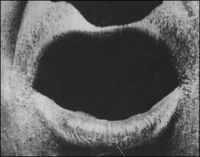Grammar
From The Art and Popular Culture Encyclopedia
| "Nothing is more usual than for philosophers to encroach on the province of grammarians, and to engage in disputes of words, while they imagine they are handling controversies of the deepest importance and concern." - David Hume |

Illustration: a close-up of a mouth in the film The Big Swallow (1901)
|
Related e |
|
Featured: |
Grammar is the study of the rules governing the use of a given natural language, and, as such, is a field of linguistics.
Contents |
As compared to film grammar
There are analogies to be drawn between film grammar and language grammar. A word for example, the second smalled linguistic unit, can be compared to a shot.
History
Template:Further The first systematic grammars originated in Iron Age India, with Yaska (6th century BC), Pāṇini (4th century BC) and his commentators Pingala (c. 200 BC), Katyayana, and Patanjali (2nd century BC). In the West, grammar emerged as a discipline in Hellenism from the 3rd century BC forward with authors like Rhyanus and Aristarchus of Samothrace, the oldest extant work being the Art of Grammar (Template:Lang), attributed to Dionysius Thrax (c. 100 BC). Latin grammar developed by following Greek models from the 1st century BC, due to the work of authors such as Orbilius Pupillus, Remmius Palaemon, Marcus Valerius Probus, Verrius Flaccus, and Aemilius Asper.
Tolkāppiyam is the earliest Tamil grammar; it has been dated variously between 1st CE and 10th CE.
A grammar of Irish originated in the 7th century with the Auraicept na n-Éces.
Arabic grammar emerged with Abu al-Aswad al-Du'ali from the 7th century who in-turn was taught the discipline by Ali ibn Abi Talib, the fourth historical caliph of Islam and first Imam for Shi'i Muslims.
The first treatises on Hebrew grammar appeared in the High Middle Ages, in the context of Mishnah (exegesis of the Hebrew Bible). The Karaite tradition originated in Abbasid Baghdad. The Diqduq (10th century) is one of the earliest grammatical commentaries on the Hebrew Bible. Ibn Barun in the 12th century compares the Hebrew language with Arabic in the Islamic grammatical tradition.
Belonging to the trivium of the seven liberal arts, grammar was taught as a core discipline throughout the Middle Ages, following the influence of authors from Late Antiquity, such as Priscian. Treatment of vernaculars began gradually during the High Middle Ages, with isolated works such as the First Grammatical Treatise, but became influential only in the Renaissance and Baroque periods. In 1486, Antonio de Nebrija published Las introduciones Latinas contrapuesto el romance al Latin, and the first Spanish grammar, Gramática de la lengua castellana, in 1492. During the 16th-century Italian Renaissance, the Questione della lingua was the discussion on the status and ideal form of the Italian language, initiated by Dante's de vulgari eloquentia (Pietro Bembo, Prose della volgar lingua Venice 1525). The first grammar of Slovene language was written in 1584 by Adam Bohorič.
Grammars of non-European languages began to be compiled for the purposes of evangelization and Bible translation from the 16th century onward, such as Grammatica o Arte de la Lengua General de los Indios de los Reynos del Perú (1560), and a Quechua grammar by Fray Domingo de Santo Tomás.
In 1643 there appeared Ivan Uzhevych's Grammatica sclavonica and, in 1762, the Short Introduction to English Grammar of Robert Lowth was also published. The Grammatisch-Kritisches Wörterbuch der hochdeutschen Mundart, a High German grammar in five volumes by Johann Christoph Adelung, appeared as early as 1774.
From the latter part of the 18th century, grammar came to be understood as a subfield of the emerging discipline of modern linguistics. The Serbian grammar by Vuk Stefanović Karadžić arrived in 1814, while the Deutsche Grammatik of the Brothers Grimm was first published in 1818. The Comparative Grammar of Franz Bopp, the starting point of modern comparative linguistics, came out in 1833.
Etymology
The word grammar derives from Greek γραμματικὴ τέχνη (grammatikē technē), which means "art of letters", from γράμμα (gramma), "letter", itself from γράφειν (graphein), "to draw, to write".
See also
- Philosophers encroaching on the province of grammarians
- Sapir-Whorf Hypothesis
- Grammaire du Décaméron

